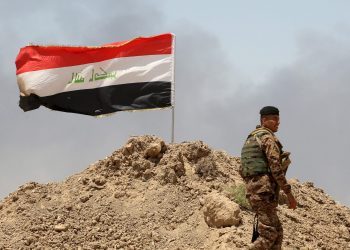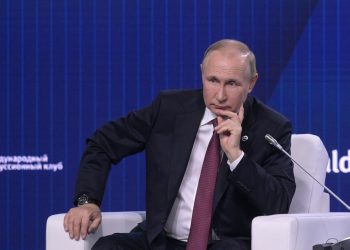National Post, For the first time since the end of the Second World War, U.S. military planners are conducting a sweeping reassessment of how and where the Pentagon bases its troops.
In a post-Cold War world filled with rogue states, terrorism and weapons of mass destruction, planners are eager to abandon the static lines of defence they laid down more than 50 years ago to curb Soviet expansion, when they prepared for a possible ground war in Europe.
Now, the Pentagon is looking seriously at withdrawing tens of thousands of troops from bases in Europe, South Korea and Japan. In an effort to make the U.S. military leaner, meaner and quicker-moving, the Pentagon wants to create a new web of far-flung operating bases in places such as Africa, Central Asia and Southeast Asia.
Manned by small permanent support groups, these new bases could be turned into staging points for future actions, with fighting forces dispatched from the United States on short notice in the event of a crisis.
The process is already under way. During the buildup and aftermath of the war in Iraq, the Pentagon has beefed-up the U.S. military presence in Djibouti on the Horn of Africa and removed all its troops from Saudi Arabia. It has also begun shifting troops and bases away from the Demilitarized Zone in South Korea.
After the war in Afghanistan, U.S. planners also began establishing new military bases in the five Central Asian republics of the former Soviet Union, building air bases and army camps in Kyrgyzstan, Uzbekistan, Kazakhstan, Tajikistan and Turkmenistan.
Pentagon planners intend nothing less than the transformation of the U.S. military. They believe increased precision, striking power and information technologies, combined with new tactics and refinements in the positioning of U.S. forces abroad can give the United States a decisive advantage against any foe.
The recent war in Iraq, with its “speed kills” strategy and “shock and awe” tactics, reinforced those beliefs. Now it is spurring Donald Rumsfeld, the Defense Secretary, to press ahead with sweeping plans to restructure the U.S. military.
An additional factor driving the reorganization process is Washington's need for reinforcements in Iraq and Afghanistan. A sudden shift in U.S. troop deployments around the world could make a large pool of combat-ready troops available for reassignment.
Last week, President George W. Bush announced his officials will step up discussions with U.S. allies on the pending overhaul of U.S. military deployments.
While insisting there is no hard plan ready to be put into place, Mr. Bush said Washington wants to consult with its allies and listen to their concerns.
“We will ensure that we place the right capabilities in the most appropriate locations to best address the new security environment,” a White House statement said.
Mr. Rumsfeld will take that message to Europe when he travels to NATO headquarters in Brussels today. Colin Powell, the Secretary of State, will follow up with a similar visit to NATO on Thursday and Friday.
The United States has 116,000 troops based permanently in Europe, 70,000 of them in Germany, and it is eager to redeploy them to countries in Eastern Europe and possibly Iraq.
U.S. troops in Europe are likely to be shifted eastward to bases in the new NATO member states, such as Romania and Bulgaria. They could also be sent to training ranges in former Warsaw Pact countries like Poland and Hungary.
A dramatic reduction of U.S. troops in Europe could prompt Germany, France and Britain to push ahead with plans to build a new European rapid reaction force that operates outside of U.S.-led NATO.
Last week, the European Union's “Big Three” agreed to set up a new military planning office that will function outside of NATO.
But it is in Asia that the new U.S. strategy will be felt most. Washington fields 47,000 troops in Japan and 37,000 in South Korea and has been discussing a possible redeployment in both places for months.
This year, Washington announced a phased pullback of 15,000 troops from the Demilitarized Zone along the border with North Korea. It has also been preparing to move a further 7,000 people in its headquarters in Seoul out of the South Korean capital within a year.
Both moves may be a prelude to more significant reductions. U.S. troops have been in South Korea since the end of the Korean War as a token of the U.S. commitment to defend the country against a North Korean attack.
Only now, with U.S. forces stretched so thinly around the globe, the U.S.Army cannot afford to keep one of its 10 divisions tied down in Korea. U.S. officials believe South Korea is strong enough to defend itself and they think they can reconfigure their forces in South Korea to free up troops for duty in Iraq and Afghanistan.
Washington may be even more eager to withdraw some of its soldiers in the wake of South Korea's recent decision to send only 3,000, mainly noncombatant, troops to Iraq for post-war peacekeeping. The United States had been pressing Seoul to send a division of 12,000 fully armed combat troops.
Still, the main drawback to an immediate U.S. withdrawal appears to be how North Korea might interpret the move. North Korea's leadership is erratic and slightly paranoid and U.S. and South Korean officials do not want Pyongyang to think a rapid U.S. pullout might be a prelude to a pre-emptive strike.
In Japan, the government seems eager to see a U.S. troop reduction.
Tensions with local Japanese in Okinawa, where most U.S. troops in Japan are based, have been growing for years. Some 17,700 U.S. Marines are currently based on Okinawa and they may be the first to leave.
Okinawa will still be an important U.S. air base in any war in Korea and it still provides the United States with a base from which it can conduct surveillance flights along the coast of China.
Any redeployment of troops in Asia may see U.S. troops sent to the Philippines, Singapore and possibly Indonesia for short terms of duty in the war on terrorism.
But it is the U.S. Navy that will likely be called upon to increase its patrols in Asian waters to project U.S. military might.









